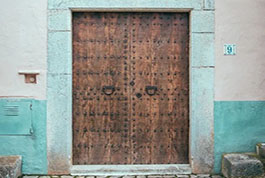Views: 37 Author: Site Editor Publish Time: 2020-12-24 Origin: Site

You may have noticed that the verification code has recently started to use the apartment numbers and letters instead of the random sequence of different letters and numbers that we don't like. From the fuzzy photos taken by Google Street View, we can see an interesting change, that is, the house number. Ironically, these numbers are now used to confirm that we are human beings.
Metal cursive house numbers were invented in the Enlightenment, and they were part of the impulse of forced classification in the 18th century, which also created Diderot's encyclopedia and public museum. At first, people named houses according to their distinctive features, such as white houses or houses opposite churches, and in villages, small towns and even cities, people were very familiar with their neighbors and environment, except for the names of residents. There is almost no need for a universal classification system to use metal house numbers and letters, but some political factors have changed this situation: taxation, postal service and conscription. In the 18th century, the state called on citizens to perform their duties in the military and tax them to pay for war expenses. With the development of the industrial revolution and the complex postal system in Europe, and the gradual expansion of the city scale, it is very necessary to record and plan the location of each household.
In the 15th century, there were some examples of stable metal address letters, but it was not until the 18th century that numbering really became popular, sometimes with sinister meanings, because the numbering of Jewish houses was widely used at the earliest, so that Jewish residents could be restricted and controlled, which was also the pioneer of Nazi tattoo figures on prisoners in concentration camps, while the Prussian army used wrought iron house numbers and letters to find accurate places to place its troops.
Because the introduction of house numbers is always an unwelcome number, which means bad things, it is often resisted. People will erase the black house letters on the wall and even conduct a comprehensive riot against the authorities. In some areas of the United States, this resistance has lasted for a long time. In 2007, residents in some areas condemned house numbers as a manifestation of the Communist Party's desire to deprive people of their personality.
The United States has contributed to the introduction of odd and even numbers on both sides of the street. Philadelphia's original numbering went up while the other continued. This numbering method led to the direct opposition between house numbers at lowes and high numbers, which was considered very strange. In 1790, it was changed to the numbering system widely used all over the world. Interestingly, some people will try to express diversity from the standardized and fixed stainless steel house letters system, such as Venice's unique black charcoal number. Moreover, blue and white enamel plaques will be used. Although there are standardized numbers, there are highly customized versions. For example, Portugal and Brazil will use hand-printed ceramic tiles or polished metal numbers.
During the German Democratic Germany, some real estates will be awarded "Golden Numbers", which can recognize some well-maintained buildings or the best gardens. After the fall of the Berlin Wall in 1989, although these buildings were abandoned, many cities still use some interesting copper house letters, such as “green numbers” to represent super sustainable buildings.
Perhaps one of the contradictions of the contemporary house numbers and letters is that this mechanism originally used for control, subscription and taxation has become one of the main ways for us to customize the house. If you have some problems about hardware in the process of customizing the house, you can ask Wenzhou Zhongwang Hardware for help.


